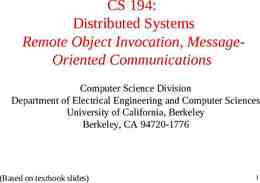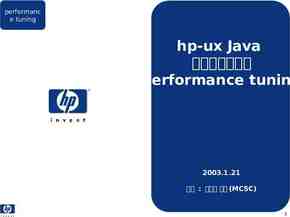Chapter 2 – Evolution of Software Economics 23 1
23 Slides151.00 KB
Chapter 2 – Evolution of Software Economics 23 1
2.1 Software Economics Five fundamental parameters that can be abstracted from software costing models: Size Process Personnel Environment Required Quality Overviewed in Chapter 2 Much more detail in Chapter 3. 23 2
Software Economics – Parameters (1 of 4) Size: Usually measured in SLOC or number of Function Points required to realize the desired capabilities. Function Points – a better metric earlier in project LOC (SLOC, KLOC ) a better metric later in project These are not new metrics for measuring size, effort, personnel needs, Process – used to guide all activities. Workers (roles), artifacts, activities Support heading toward target and eliminate non-essential / less important activities Process critical in determining software economics Component-based development; application domain iterative approach, use-case driven Movement toward ‘lean’ everything! Process 23 3
Software Economics – Parameters (2 of 4) Personnel – capabilities of the personnel in general and in the application domain in particular Motherhood: get the right people; good people; Can’t always do this. Much specialization nowadays. Some are terribly expensive. Emphasize ‘team’ and team responsibilities Ability to work in a team; Several newer light-weight methodologies are totally built around a team or very small group of individuals 23 4
Software Economics – Parameters (3 of 4) Environment – the tools / techniques / automated procedures used to support the development effort. Integrated tools; automated tools for modeling, testing, configuration, managing change, defect tracking, etc Required Quality – the functionality provided; performance, reliability, maintainability, scalability, portability, user interface utility; usability 23 5
Software Economics – Parameters (4 of 4) Effort (personnel)(environment)(quality)(size ) Process (Note: effort is exponentially related to size .) What this means is that a 10,000 line application will cost less per line than a 100,000 line application. These figures – surprising to the uninformed – are true. Fred Brooks – Mythical Man Month – cites over and over that the additional communications incurred when adding individuals to a project is very significant. Tend to have more reviews, meetings, training, biases, getting people up to speed, personal issues Let’s look at some of the trends: 23 6
Notice the Process Trends .for three generations of software economics Conventional development (60s and 70s) Application – custom Size – 100% custom Process – ad hoc (discuss) – laissez faire; SDLC; customization of process to domain / mission Transition (80s and 90s) Environmental/tools – off the shelf, separate Size: 30% component-based; 70% custom Process: repeatable Modern Practices (2000 and later) Environment/tools: off-the-shelf; integrated Size: 70% component-based; 30% custom Process: managed; measured (refer to CMM – 23 Software) 7
Notice Performance Trends .for three generations of software economics Conventional: Predictably bad: (60s/70s) always over budget and schedule; missed requirements All custom components; primitive languages; Performance, quality almost always less than great. Transition: Unpredictable (80s/90s) Infrequently on budget or on schedule Enter software engineering; ‘repeatable process;’ project management Some commercial products available – databases, networking, GUIs; But with huge growth in complexity, (especially to distributed systems) existing languages and technologies not enough for desired business performance Modern Practices: Predictable ( 2000s) Usually on budget; on schedule. Managed, measured process management. Integrated environments; 70% offthe-shelf components. Component-based applications can be built very rapidly; iterative development; stakeholder emphasis. RAD! 8 23
All Advances Interrelated Improved ‘process’ requires ‘improved tools’ (environmental support ) Better ‘economies of scale’ because Applications live for years; Similarly-developed applications – common. First efforts in common architectures, processes, iterative processes, etc., all have initial high overhead; successive efforts bring out economies of scale and much better return on investment. (See p. 25) “All simple systems have been developed!” 23 9
2.2 Pragmatic Software Cost Estimation Little available on estimating cost for projects using iterative development. Difficult to hold all the controls constant Application domain; project size; criticality; etc. Very ‘artsy.’ Metrics (SLOC, function points, etc.) NOT consistently applied EVEN in the same application domain! Definitions of SLOC and function points are not even consistent! Much of this is due to the nature of development. there is no magic date when design is ‘done;’ or magic date when testing ‘begins’ 23 10
Three Issues in Software Cost Estimation: 1. Which cost estimation model should be used? 2. Should software size be measured using SLOC or Function Points? (there are others too ) 3. What are the determinants of a good estimate? (How do we know our estimate is good?) So very much is dependent upon estimates!!!! 23 11
Cost Estimation Models Many available. Many organization-specific models too based on their own histories, experiences. Oftentimes, these are super if ‘other’ parameters held constant, such as process, tools, etc. etc. COCOMO, developed by Barry Boehm, is the most popular cost estimation model. Two primary approaches: Source lines of code (SLOC) and Function Points (FP) 23 12
Source Lines of Code (SLOC) Many feel comfortable with ‘notion’ of LOC SLOC has great value – especially where applications are custom-built. Easy to measure & instrument – have tools. Nice when we have a history of development with applications and their existing lines of code and associated costs. Today – with use of components, source-code generation tools, and objects have rendered SLOC somewhat ambiguous. We often don’t know the SLOC – but do we care? How do we factor this in? 23 13
Source Lines of Code (SLOC) In general, using SLOC is a more useful and precise basis of measurement. See Appendix D – an extensive case study. Addresses how to count SLOC where we have reuse, different languages, etc. We will address LOC in much more detail later. In the meantime, I urge you to read the five pages in Appendix D entitled, Software Size Evolution from the Case Study. Starts on page 348. This exposition provides a hint at the complexity of using LOC for software sizing particularly with the new technologies using automatic code generation, components, development of new code, and more. Read these five pages. 23 14
Function Points Use of Function Points - many proponents. International Function Point User’s Group – 1984 – “is the dominant software measurement association in the industry.” Check out their web site Tremendous amounts of information / references Attempts to create standards . Major advantage: Measuring with function points is independent of the technology (programming language, ) used and is thus better for comparisons among projects. 23 15
Function Points Function Points measure numbers of external user inputs, external outputs, internal data groups, external data interfaces, external inquiries, etc. Major disadvantage: Difficult to measure these things. Definitions are primitive and inconsistent Metrics difficult to assess especially since normally done earlier in the development effort using more abstractions. 23 16
But: Regardless, cost estimation is a real necessity!!! Necessary to ‘fund’ project! All projects require estimation in the beginning (inception) and adjustments These must stabilize; They are rechecked Must be reusable for additional cycles Can create organization’s own methods of measurement on how to ‘count’ these metrics. No project is arbitrarily started without cost / schedule / budget / manpower / resource estimates (among other things) SO critical to budgets, resource allocation, and to a host of stakeholders 23 17
So, How good are the models? COCOMO is said to be ‘within 20%’ of actual costs ’70% of the time.’ (COCOMO has been revised over the years ) Cost estimating is still disconcerting when one realizes that there are already a plethora of missed dates, poor deliverables, and significant cost overruns that characterize traditional development. Yet, all non-trivial software development efforts require costing; It is a basic management activity. RFPs on contracts force contractors to estimate the project costs for their survival. 18 23
Top Down versus Bottom Up Substantiating the Cost Most estimators perform bottom up costing - substantiating a target cost - rather than approaching it a top down, which would yield a ‘should cost.’ Many project managers create a ‘target cost’ and then play with parameters and sizing until the target cost can be justified Attempts to win proposals, convince people, Any approach should force the project manager to assess risk and discuss things with stakeholders 23 19
Top Down versus Bottom Up This can be good and bad If well done, it requires considerable analysis and expertise based on much experience and knowledge; development of similar systems a great help; similar technologies – great help If not well done, causes team members to go crazy! (This is not uncommon) Independent cost estimators (consultants ) not reliable. 23 20
Author suggests: Likely best cost estimate is undertaken by an experienced project manager, software architect, developers, and test managers – and this process can be quite iterative! Previous experience is essential. Risks identifiable, assessed, and factored in. When created, the team must live with the cost/schedule estimate. More later in course. But for now 23 21
A Good Project Estimate: Is conceived and supported by the project manager, architecture team, development team, and test team accountable for performing the work. Is accepted by all stakeholders as ambitious but doable Is based on a well-defined software cost model with a credible basis Is based on a database of relevant project experience that includes similar processes, similar technologies, similar environments, similar quality requirements, and similar people, and Is defined in enough detail so that its key risk areas are understood and the probability of success is objectively assessed. 23 22
A Good Project Estimate Quoting: “An ‘ideal estimate’ would be derived from a mature cost model with an experience base that reflects multiple similar projects done by the same team with the same mature processes and tools. “Although this situation rarely exists when a project team embarks on a new project, good estimates can be achieved in a straightforward manner in later life-cycle phases of a mature project using a mature process.” 23 23




























